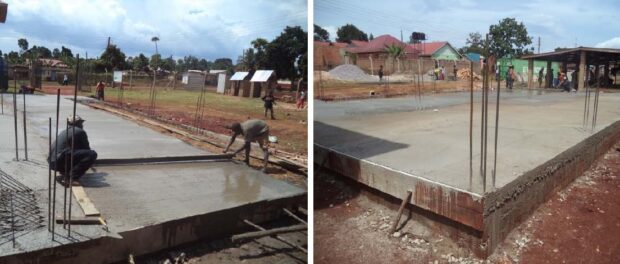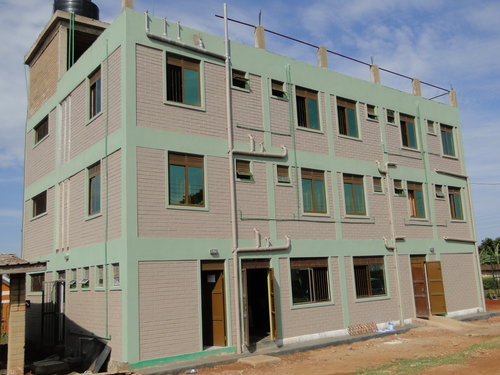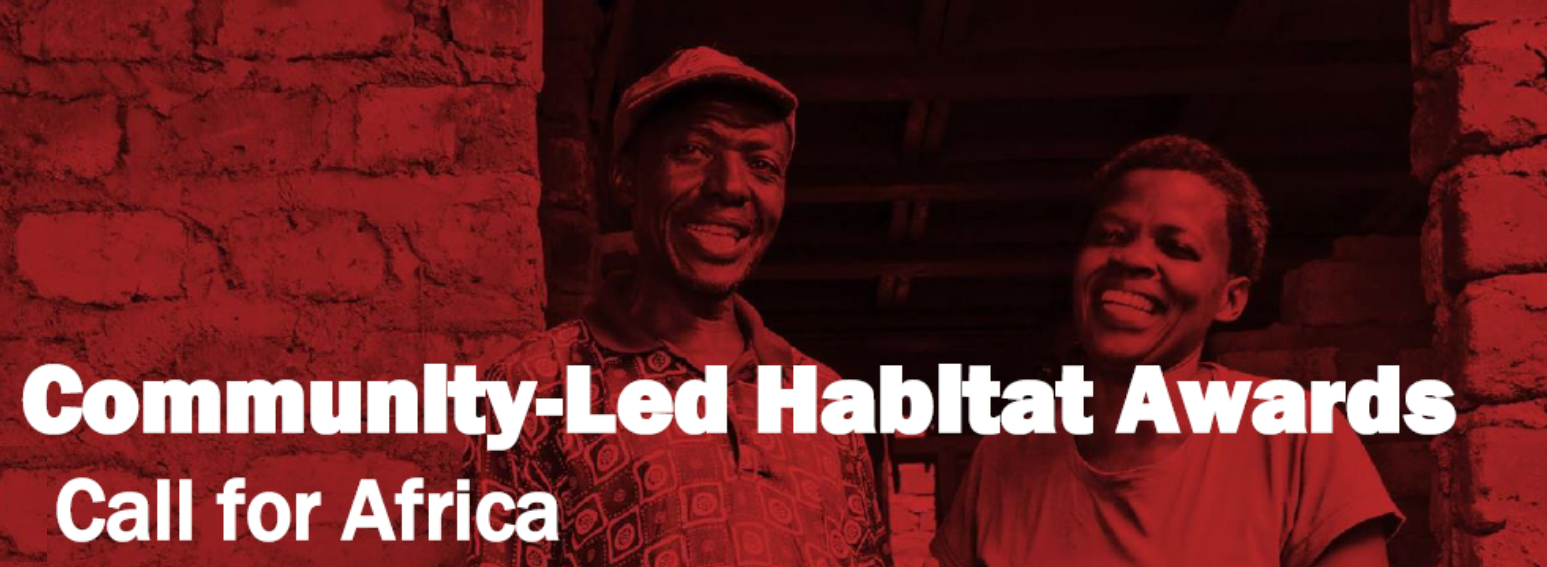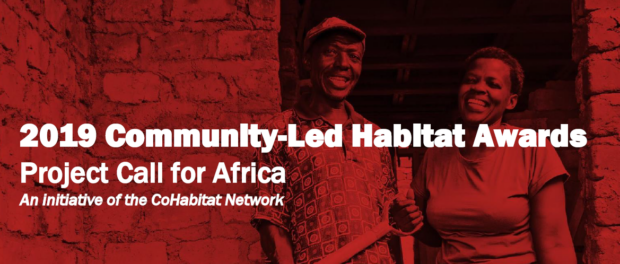
Here on RioOnWatch, we often report on community-based solutions to housing and urban development in Rio. With this focus in mind, on occasion, we may publish articles such as this one, highlighting solutions to housing and infrastructure issues piloted by communities across the world.
This article profiles three initiatives that were awarded the 2019 Community-Led Habitat Award by The Co-Habitat Network, an organization supporting ground-up, community-based solutions to housing and development in Africa. These awards recognize innovative approaches to reclaiming housing rights among geographically and politically marginalized populations. Whereas urban development is often top-down, framed by politicians with little or no community control, these initiatives engage the communities with a stake in the matter as the most capable and important agents of change. Beyond providing recognition, the awards also inform dialogue and sharing of best practices at the United Nations Governing Council in Nairobi, Kenya.
The Dzivarasekwa Informal Settlement Upgrading Project: Dzivarasekwa Extension, Zimbabwe
Based in the Dzivarasekwa Extension (DZ Ext) in Zimbabwe, the Dzivarasekwa Informal Settlement Upgrading Project demonstrates the far-reaching impact that community-led initiatives can achieve when bolstered by receptive local and national policymakers. Today, the ambitious project works to develop the housing situation, sanitation infrastructure, technical capacity, and financial autonomy of 480 families living in the DZ Ext community. Engaging community, local, and national stakeholders, the project is jointly carried out and supported by the Zimbabwe Homeless People’s Federation, the Dialogue on Shelter for the Homeless Trust, Slum Dwellers International, the Harare City government, and the central government of Zimbabwe.
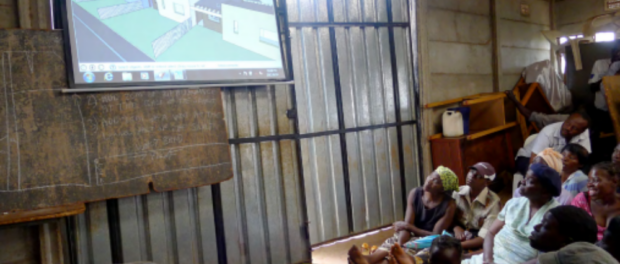
Located nearly 20 kilometers west of Harare, Zimbabwe’s capital and most populous city, DZ Ext was created by the government in 1993 as a holding camp for evictees removed from the high-density Harare suburbs of Mbare and Epworth, both of which had seen rapid growth outpace infrastructure developments. Some of these evictees were then sent to the Hatcliffe area of Harare in 2004, where they received more permanent government-allocated plots. Prior to this relocation, DZ Ext was home to 2000 families—a number which swelled and shrunk over the years, as widespread government evictions and forced informal settlement clearance displaced families across the country. These State-led efforts were part of Operation Murambatsvina (Restore Order), which aimed to reduce the prevalence of informal housing and activities throughout the country. In 2007, the State gave control of DZ Ext to the Zimbabwe Homeless People’s Federation. As of 2014, most of the 450 families in DZ Ext were members of the Federation.
Since the land had already been allocated for the purpose of pro-poor housing structure and policy, the City Council of Harare and the Zimbabwe central government decided to develop houses and infrastructure using DZ Ext as a pilot project in upgrading to demonstrate the potential of high-density residential models to sustain affordable and adequate infrastructure. Primarily, the efforts by a coalition of City employees and community members have focused on creating new housing unit models and improving the sanitation and water facilities through the construction of more boreholes and Ecosan toilets to replace the previous pit latrines (Ecosan toilets are superior as they use a closed system, thus avoiding the risk of groundwater contamination).
Many of the challenges that have plagued the DZ Ext community have to do with the challenges of urban sprawl. The community’s significant distance from Harare results in a lack of appropriately connected amenities, namely water and sewerage infrastructure. After the Federation requested residential structures from local government officials, the City Council of Harare provided expertise and human resources for installing necessary infrastructure—such as water, reticulation, and roads—in the community. The Dialogue and Federation, meanwhile, led the “superstructure” interventions, with the Homeless Federation bearing the brunt of the work for home construction, maintaining a strong focus on capacity-building throughout implementation. With the City and other institutional partners, male and female residents received training in the upgrading and maintenance of the new construction, ranging from topics such as solar installations to brick-laying.
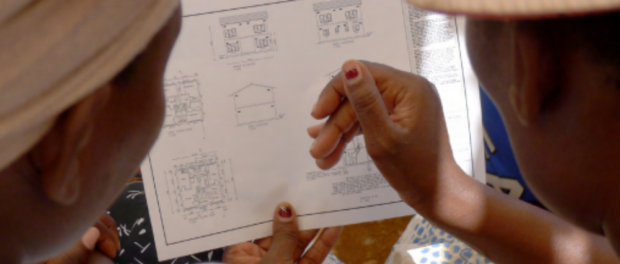
Community members and local policymakers cite their partnership and division of labor as the key to DZ Ext’s success over the initial five years of the collaboration and beyond. Wins include the development of local capacity to construct homes, community structures, and sustainable sanitation infrastructure for over 480 families in the area based on their own understanding of the area’s needs. To achieve this, the leadership of the project held numerous meetings and community forums to incorporate input and address concerns from DZ Ext residents. Pushback came from feelings of distrust and wariness regarding the intentions of the government: some residents felt that “densification” was merely a euphemism for forcibly pushing community members into apartments.
The recognized efforts in DZ Ext are part of a larger effort called the Harare Slum Upgrading Project, which seeks to improve communities throughout the region, and reflects the collaboration between the Federation, the Dialogue, and central and local governments. Part of the Harare Slum Upgrading Project is the expansion of a financing facility (HSUFF) and its activities beyond just the DZ Ext, where it has been providing loans over the last few years. By 2016, this financing facility had issued over 150 loans to approximately 550 households, issuing loans in four categories: income generation, water and sanitation, housing, and land acquisition.
Brenda Hove, part of the HSUFF management team, explains that the financing program began to experience challenges with disbursements and repayments after a relatively smooth start in 2014, coinciding with volatility in the national currency. “When the cash shortages began to flare up, it affected our disbursements, because we used to disburse loans via the bank. But we couldn’t continue doing that, because the clients were facing challenges withdrawing those loans from the bank… They were being given smaller amounts every day, and quite a sizable chunk of the loan would go to bank charges,” said Hove. In order to adapt, HSUFF was forced to switch to a cash-based system for repayments and disbursements. However, even this was not a permanent solution; the businesses depend on the public to purchase their wares, and given the instability of cash flow, customers became wary of spending their money. As the program looks to scale in scope and size, developing a solid financial structure will be crucial.
Five nearby settlements which were profiled along with DZ Ext by the government are now attempting to learn from and replicate the work that has been done in DZ Ext. While the DZ Ext efforts are nowhere near finished, and each context will require unique conversation and adaptation, the collective efforts and accomplishments in DZ Ext are encouraging.
The Walukuba Material Building Training Center: Jinja City, Uganda
The Walukuba Material Building Training Center, founded in 2015 and located in the small community of Walukuba in Jinja City, Uganda, merges production and education innovatively through establishing a multi-purpose building including workshop, community hall and a hostel. While constantly being used for social gatherings and community meetings, citizens from all regions of Uganda are invited to come and learn how to build low-cost buildings with appropriate and sustainable materials.
The idea, planning, and implementation came out of a partnership between the National Slum Dwellers Federation of Uganda (NSDFU), ACtogether Uganda, members of Slum Dwellers International (SDI), and the City of Jinja. In a memorandum of understanding, all parties decided to construct the training center and support low-cost housing construction and education within the municipal boundaries.
The project describes its benefits to the wider community of Walukuba in terms of economic, ecological, and social advantages. While striving to provide Walakuba’s younger and female population with the capacity to independently produce sustainable material compounds and knowledge of their assembly during construction, the training center also creates employment for six community members and ten more citizens from other regions of Uganda working on the construction site. The project also achieves an appreciable social impact by having created a new space for community meetings and gatherings. According to the alliance of NSDFU and ACtogether, their interagency collaboration has already led to a consolidation of the relationship between the greater municipality, the local community, and the alliance as an independent development partner. Last, the project has supported ecological consciousness, placing an educational focus on eco-friendly materials that are cheaply available in flexible quantities.
According to the founders of the Material Building Training Center, the NSDFU generates additional income through training and building material fees as well as the renting out of community hall and hostel rooms to independent hosts, visitors, and participants. The NSDFU redistributes this revenue to other projects in informal settlements in which they and the state operate. The financing came from a US$17,777 government subsidy and US$20,586 from Slum Dwellers International (SDI). ACTogether and NSDFU work in an alliance and as representative members of SDI to provide funding and local community action to promote pro-poor policy and practice in urban development. ACTogether also monitors the project in collaboration with the city of Jinja through monthly project reports by the members responsible for running the center. One major challenge that remains for the project, however, is that local tax departments have failed to recognize the training center as a non-profit community initiative. The center thus struggles with the high costs of water, electricity, and hostel room taxes—costs that would otherwise be abated by an NGO status. The project thus has a ways to go in achieving closer collaboration and transparency between city and state tax departments.
Three positive points can be derived from the successful practice of the Walukuba Material Building Training Center, and may provide lessons for other communities. First, while being available to every community member, the focus on youth and women is a considerable factor–not only as a countermeasure against unemployment among young people but also for a just society in which men and women are equally empowered to build their own dwelling spaces. Second, the establishment of a building and construction education center focusing on sustainable building materials efficiently contributes to a broad field of ecological practice. And third, the training center sets an exciting precedent for a successful partnership between the City, the local community, and third-party development partners, in this case, represented by ACtogether and the NSDFU as financial supporters and knowledgeable mediators.
Home Improvement and Reconstruction Project: Dakar, Senegal
Since its inception in 2015, the Home Improvement and Reconstruction Project in Dakar, Senegal has rebuilt and fortified over 300 homes in suburban informal settlements to mitigate the impacts of flooding and other climate risks. The project was spearheaded by the Senegalese Federation of Inhabitants (FSH), a federation of over 5,000 residents of the informal settlements of Dakar. In partnership with Dakar-based NGO UrbaSEN, FSH financed the project through an innovative “revolving fund” (a self-replenishing pool of money that utilizes interest and principal payments on old loans to issue new ones) that has provided its members access to affordable financing for home improvement projects. While the FSH/UrbaSEN fund received start-up capital from Swiss and French development agencies, the revolving fund soon expanded and scaled up through the collective savings of members of FSH. All 5,000 members contribute 5,000 Senegalese francs per month, per savings group. FSH members then receive loans through the fund to improve their homes that have to be paid back within 20 months. Interest is 5%: 1% goes to the beneficiary’s savings group, 1% to FSH, 1% to UrbaSEN, and 2% to the revolving fund to cover recovery risk.
Using these loans, FSH members can protect their homes from flood risks by lifting or raising their floors, improving roofs, and reinforcing infrastructure. Other home improvements such as sanitation facilities, additional rooms, or extra floors are also covered. Local craftsmen exclusively carry out all construction, and UrbaSEN both organizes the construction and trains savings groups to oversee the sites so they are able to identify problems or safety risks.
Although the FSH/UrbaSEN project officially commenced in 2014, the seeds of the initiative were sown over a decade prior by inhabitants of Djiddah Thiaroye Kao (DTK). DTK, a municipality of the City of Pikine in the suburbs of Dakar, was heavily impacted by recurring floods in the early 2000s. The floods displaced a significant number of families, while others lived in a constant state of fear that their homes would be destroyed.
In 2005, in response, the Senegalese Government implemented an emergency response plan to construct flood-mitigating rainwater retention basins and relocate those who had been affected by floods. The primary infrastructure for these basins was constructed through the Rainwater and Climate Change Adaptation Project (PROGEP), run by the Senegalese Agency for Municipal Development. PROGEP also constructed basic housing for displaced families in Dakar, 30km away from their initial settlements. However, while PROGEP built primary infrastructure in these new settlements, secondary and tertiary infrastructure was still lacking. The successful mitigation of flooding due to the retention basins also led to re-establishment of settlements in DTK that had previously been abandoned due to flooding. PROGEP did not provide funding for residents to rebuild these already existing homes, which were often damaged or poorly constructed, and thus vulnerable to climate risks.
Noticing the gap in PROGEP’s programming, DTK residents began to self-organize in order to reinforce their homes against flooding. Community groups initially mobilized by placing sand sacks in flood-affected areas and making small landfills to reduce neighborhood pollution. However, realizing that more drastic preventative measures were necessary, DTK residents formed a collective of regional residents associations (called CADDTK) and put out an international call to development professionals and technical support actors to ask for assistance developing sustainable solutions to their flood and infrastructure problems.
In 2009, CADDTK partnered with Swiss NGO UrbaMonde and Senegalese professionals (urban planners, engineers, development specialists) to form the NGO UrbaSEN. The new NGO’s aim was to launch a participatory upgrading process in DTK, to raise awareness about the causes and impacts of urban flooding in the area. They also hoped to advocate for “the effective implementation of flood and climate change mitigation policies at a local and national level.”
UrbaSEN, inspired by the success of the community mobilization movement in DTK, also decided to facilitate a larger dialogue about flood mitigation amongst Dakar’s informal settlements. In 2014, in partnership with Slum Dwellers International (SDI), they fostered a series of dialogues with residents that ultimately resulted in the formation of FSH. Currently, FSH federates over 5,000 members in the suburban informal settlements of Dakar. The residents are organized into 200 savings groups, which are arranged around collective savings, income-generating activities, data collection, and the revolving fund that finances FSH’s Home Improvement and Reconstruction Project.
Thanks to the Home Improvement and Reconstruction Project, 313 families have rebuilt or improved their homes since 2015. The project has expanded from the DTK municipality to 15 other municipalities in suburban Dakar, and organizers are aiming to rebuild and improve another 400 homes in the area by 2021. FSH/UrbaSEN uses innovative mapping technology and data collection to monitor the success of their programs and keep track of high priority areas that are disproportionately impacted by flooding. FSH/UrbaSEN has also launched a center for sustainable construction, and in the future, hopes to integrate more sustainable building materials into their construction projects.
FSH and UrbaSEN have done an admirable job fortifying Dakar’s urban settlements from flooding and climate risks by catalyzing community participation in home improvement and reconstruction projects, and by using an innovative sustainable finance model that protects the project’s longevity. Undoubtedly, other cities that are suffering from devastating floods—such as Rio de Janeiro—could learn from the FSH/UrbaSEN model.
Lessons for Rio
Although each project discussed takes place in a unique context with specific local needs, several lessons can be applied to strategic organizing in Rio communities:
- Informal shouldn’t mean invisible: In the face of institutional neglect and a lack of “formal” housing options, people make do. The most sustainable and equitable residential solutions, highlighted in Uganda, Zimbabwe, and Senegal, consider the resilience and adaptability of the communities in question, rather than prioritizing formal city space and greenfield developments. Often, as in the case of DTK’s flood-reinforcement efforts, community members begin solving problems long before they appear on the radar of politicians and government officials.
- Build local capacity: In Uganda, the city of Jinja provided valuable funding and institutional support for initiatives led by community-based organizations. Perhaps the most valuable role that government agencies and institutions can play is to focus on developing the skills and knowledge among community members that will allow them to solve problems and create appropriate solutions in the future. Here, supporting institutions have a unique opportunity to specifically develop the abilities of marginalized populations, such as by empowering women and younger residents in Walukuba to create their own materials and shape their dwelling spaces. It is furthermore important that close collaboration and transparency on different governance levels occur to avoid adverse municipal taxation of government-supported projects.
- Focus on finances: As programs start to scale, both in and out of the initial community, it becomes increasingly important that they sustain themselves and their residents’ efforts without a heavy reliance on grants and philanthropy from outside sources. Often, this is a challenge in politically and economically unstable contexts, such as those faced by the HSUFF during Zimbabwe’s volatile currency climate over the last several years which led them to implement a cash-based loan system. However, by committing to the financial autonomy of community members and their changing needs, housing efforts can stay resilient and continue to grow.

